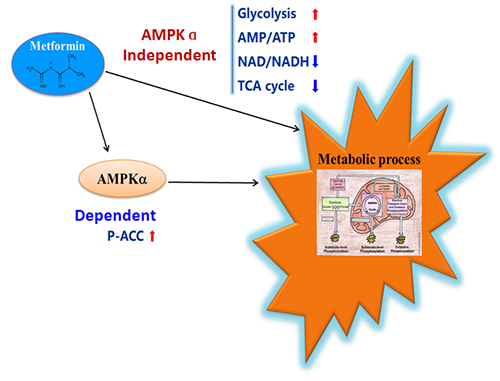Recently, scientists from the Dalian Institute of Chemical Physics (DICP) of the Chinese Academy of Sciences discovered that metformin could lead to metabolic reprogramming by passing AMPKα. Their finding was published in Metabolism-Clinical and Experimental.

Metformin Ampkα-independently increases Glysolysis and AMP/ATP ratio, decreases TCA cycle and NAD/ NADH ratio. While, metformin Ampkα-dependently increases p-ACC activation. (Image by QI Huan and WANG Ting)
Metformin is widely used as a hypoglycemic drug due to its desirable safety and surprising therapeutic efficacy for type 2 diabetes (T2D). Also, metformin has been linked to reduced incidence of cancer among diabetics who take this medicine. Thus, metformin has gained considerable attention as a potential anticancer agent.
AMP-activated protein kinase (AMPK), a heterotrimeric complex composed of α, β and γ subunits, plays a critical role in many biological processes, including metabolism, cell growth, autophagy and apoptosis. However, whether AMPK? contributes to such effects of metformin remains controversial.
The scientists found that metformin treatment obviously suppressed tricarboxylic acid (TCA) cycle, elevated lactate production and reduced the energy state by passing AMPK? via performing integrative metabolomics analyses to systematically examine the effects of metformin on metabolic pathways in Ampka1 wild type (WT) and knock-out (KO) mouse embryonic fibroblast (MEF) cells. Moreover, the replenishment of glutamine or sodium pyruvate could both reverse metformin-induced growth inhibition. And based on three-dimensional colony formation assays, metformin was also found to remarkably inhibit clonogenicity of HCC cell lines in an AMPKα-independent manner.
This study provides a new insight for the clinical application of metformin.
This study was supported by the National Key Research and Development Program of China, National Natural Science Foundation of China grants, Innovation program of science and research from the DICP, CAS and the 100 Talents Program of Chinese Academy of Sciences. (Text by QI Huan and WANG Ting)